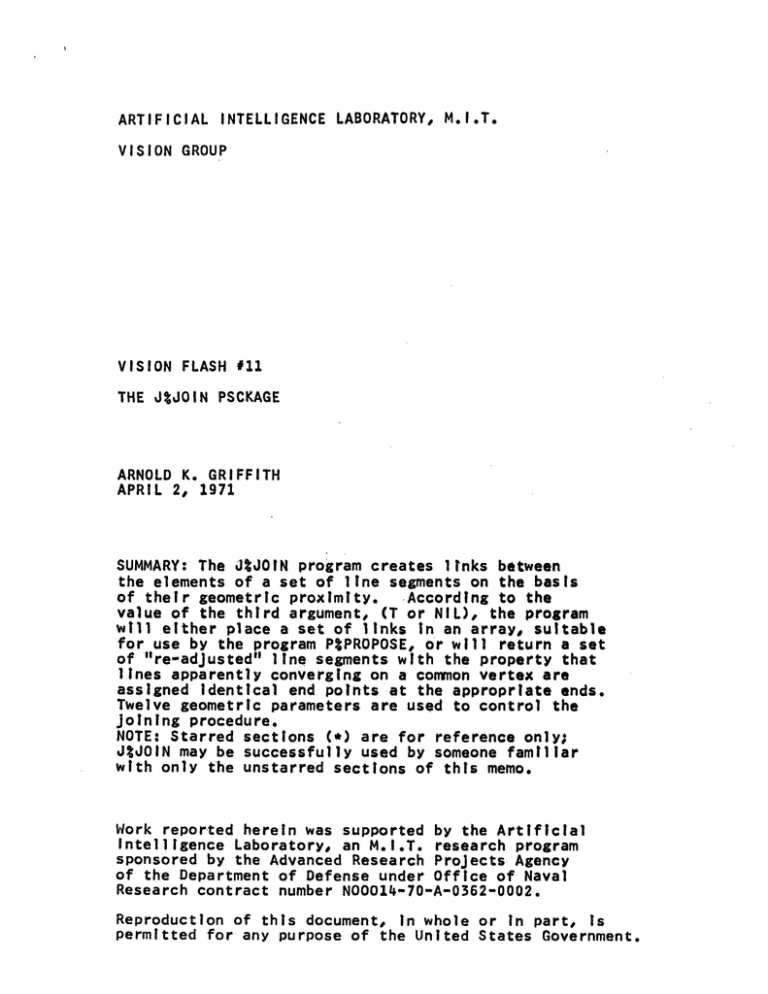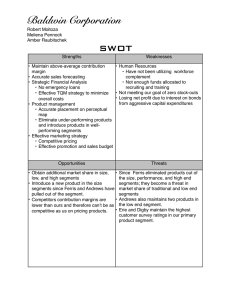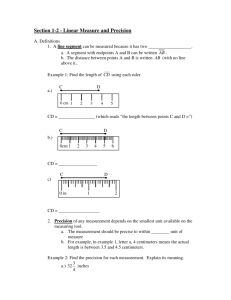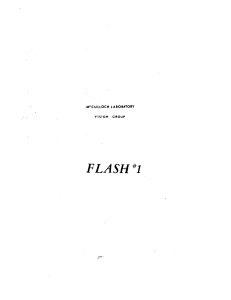INTELLIGENCE THE ARNOLD K. GRIFFITH 1971
advertisement

ARTIFICIAL INTELLIGENCE LABORATORY, M.I.T. VISION GROUP VISION FLASH #11 THE JJOIN PSCKAGE ARNOLD K. GRIFFITH APRIL 2, 1971 SUMMARY: The JJO1N program creates links between the elements of a set of line segments on the basis of their geometric proximity. According to the value of the third argument, (T or NIL), the program will either place a set of links in an array, suitable for use by the program PPROPOSE, or will return a set of "re-adjusted" line segments with the property that lines apparently converging on a common vertex are assigned identical end points at the appropriate ends. Twelve geometric parameters are used to control the joining procedure. NOTE: Starred sections (*) are for reference only; J%JOIN may be successfully used by someone familiar with only the unstarred sections of this memo. Work reported herein was supported by the Artificial Intelligence Laboratory, an M.I.T. research program sponsored by the Advanced Research Projects Agency of the Department of Defense under Office of Naval Research contract number N00014-70-A-0362-0002. Reproduction of this document, in whole or in part, is permitted for any purpose of the United States Government. I. USING THE FUNCTION JJOIN To use the @JJOIN function the user need only understand the calling sequence: (JJOIN L N SW) where: L is a list of the form: (((Xl Y1)(X1 1 Y11)) ((X2 Y2)(X2' Y2')) ((Xn Yn)(Xn' Yn'))) representing N line segments. P should be equal to the number of scan lines used in obtaining the lines , if t.hey were obtained using If the lines came from FFEATURPOINTS and LMLINES. some other source, then P should be 1,000/A, where A is the expected error in the locations of the end If the lines are from a region points of the lines. bounded by (0 0) and (1,000 1,000), one might try N-50, for lack of a better choice. SW is T or NIL depending on the desired mode, defined as follows: 1) If S is NIL, a set of links appropriate for use by the function PPROPOSE (Q. V.) is placed in an array "INFO", and the value returned by JJOIN Is NIL. 2) If SW has the value T , then the value returned by JtdOIN is a list of quadruples, representing a set of line segments which are joined end to end and represent approximately the same scene as the original (unjoind) set of segments. II. AVAILABILITY Link to, or obtain the file J% >, on DSK Load into a LISP or AKG, or tape "t SYSTEMS". PLANNER which has a LAP (Q.V.) The uncompiled version takes about 4,000 words of binary program space, and about 3,000 words of free storage. When compiled, about 6,000 binary program space words are required. III. *NULL THIRD ARGUMENT FOR JJOIN THE FUNCTION OF PUTLINE The result of executing J;JOIN with a null third argument is to fill the array INFO with 3N entries, three (INFO M 0) for each of the line segments of the argument. contains the "first" end point of the Mth segment, (INFO M 1) contains the "second" end point, and (INFO M 2) contains a These links are created list of links to the M-th line. by the function PUTLINE, which compares the given line with all others to determine whether they should be merged with, The criterion for merging or linked to, the given one. two lines is embodied in the function MERGEPRED which merges two lines under either of the following two conditions: 1) If the segment Q1 Q2, as in the figure below *ia . ~hqWtrp is within the two lines "A" and "B" positioned relative to P1 P2 according to the parameter MP1 as in the diagram, and if the distances "a" and "b" have the property: ial + Ibl+ ja + bliMP2, then the two lines are merged together. By this is meant that they are replaced by a third whose endpoints are approximately the averages of the endpoints of the original two segments. 2) If either end of a segment Q1 Q2 is within the area denoted by "A" in the diagram, and the tangent *%a-_ 11% 1 4-' Loot 141130 ~ of the angle between the two lines is less than MP3, then the lines are merged, as before. A link Is established from a line P1 P2 to a line Q1 Q2 on the basis of the relationship of Q1 Q2 to the regions around P1 P2 defined by the following diagram. 4- .0-a P -4S If any point of Q1 Q2 lies within region "A", or if either end point Q1 or Q2 lies within region "B", then By this is meant a link from P1 P2 to Q1 Q2 is made. that a "link" is added to the list on (INFO N 2), where N is the serial number of the segment P1 P2. IV. *NON-NULL THIRD ARGUMENT FOR JtJOIN If the third argument given to jjoin is T, then the vertices of the line figure defined by the actual intersections of linked (by the aforemantioned procedure) pairs of lines are grouped into sets which are assumed to be all from a common vertex. The points in these sets are spatially "averaged" to provide new vertices, and the original line segments are broken into subsegments which are pass through these "readusted" vertices. The criterion for groupung two intersection points of linked lines (i.e. for assuming that they represent the same vertex) is that they are within TH1 units of each other. An example of the action of dJOIN In this mode Is given below, where the "unlinked" set of lines to the left is converted to the "llnked" set on the right.






